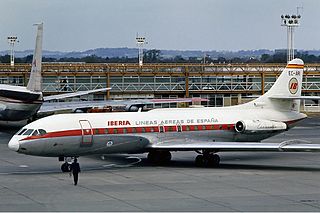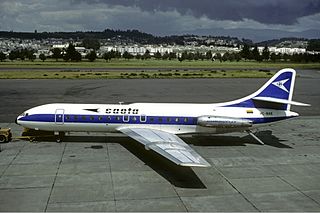Iberia, legally incorporated as Iberia, Líneas Aéreas de España, S.A. Operadora, Sociedad Unipersonal, is the flag carrier airline of Spain, founded in 1927. Based in Madrid, it operates an international network of services from its main base of Madrid–Barajas Airport. Iberia, with Iberia Regional and with Iberia Express, is a part of International Airlines Group. In addition to transporting passengers and freight, Iberia Group carries out related activities, such as aircraft maintenance, handling in airports, IT systems and in-flight catering. Iberia Group airlines fly to over 109 destinations in 39 countries, and a further 90 destinations through code-sharing agreements with other airlines.

The Sud Aviation SE 210 Caravelle is a French jet airliner produced by Sud Aviation. It was developed by SNCASE in the early 1950s, and made its maiden flight on 27 May 1955. It include some de Havilland designs and components developed for the de Havilland Comet. SNCASE was then merged into the larger Sud Aviation conglomerate before the aircraft entered revenue service on 26 April 1959 with Scandinavian Airlines System (SAS). Until the production end in 1972, 282 have been built. It was operated in every continent until its retirement in 2005.
This is a list of aviation-related events from 1973:
This is a list of aviation-related events from 1976:
This is a list of aviation-related events from 1977, This is the year of the second-deadliest air disaster in history, the Tenerife airport disaster. Here are the aviation events of 1977:
Spantax S.A. was a Spanish leisure airline headquartered in Madrid that operated from 1959 to 1988. Spantax was one of the first Spanish airlines to operate tourist charter flights between European and North American cities and popular Spanish holiday destinations and was considered a major force in developing 20th-century mass tourism in Spain. Its popularity and image faded from the 1970s onward when a series of crashes and incidents revealed safety deficits, which, combined with rising fuel costs and increasing competition, resulted in the company facing severe financial difficulties that led to its demise in 1988.

Ibiza Airport is the international airport serving the Balearic Islands of Ibiza and Formentera in Spain located 7 km (4.3 mi) southwest of Ibiza Town. As the island is a major European holiday destination, it features some year-round domestic services as well as several dozen seasonal routes to cities across Europe. It is also used as a seasonal base for Vueling.
Iberia Líneas Aéreas de España, S.A., usually shortened to Iberia, is the largest airline of Spain, based in Madrid.

A domestic JAT Yugoslav Airlines flight, carried out by a Sud Aviation SE-210 Caravelle 6-N, was nearing its end completing a scheduled domestic Flight JU 769 from Skopje, SR Macedonia to Titograd, SR Montenegro when it crashed into Maganik mountain killing all 41 passengers and crew, along with the aircraft being written off.

SA de Transport Aérien Flight 730 was a Sud Aviation SE-210 Caravelle 10R aircraft, registered as HB-ICK, that crashed on approach to Funchal Airport, Madeira, on December 18, 1977.

Iberia Airlines Flight 062 was a twin-engined Sud Aviation Caravelle registered EC-BDD operating a scheduled flight from Málaga Airport, Spain, to London Heathrow Airport. While on approach to Heathrow on 4 November 1967, the Caravelle descended far below the flight level assigned to it and flew into the southern slope of Blackdown Hill in West Sussex, killing all 37 on board.

Aviaco Flight 118 was a Sud Aviation SE 210 Caravelle operated by Aviaco that crashed in the village of Montrove, Spain on 13 August 1973, while attempting to land at Alvedro Airport in heavy fog. The aircraft crashed into an abandoned farmhouse approximately 2 kilometres from the airport. All 85 persons on board perished in the crash and subsequent fire. One person in the village also died.

Air France Flight 2005 of 12 September 1961 was a scheduled international passenger flight from Paris-Orly Airport to Casablanca Airport with a stop at Rabat-Salé Airport. The Sud Aviation Caravelle aircraft crashed that day at 21:09 GMT near a place called Douar Doum 8.4 km from the threshold of runway 04 and 1.4 km to the left of the extended centreline at a height of 87.5m above sea level, killing all 77 people on board, including 6 crew members. The weather was foggy and unfavourable for landing.

Iberia Airlines Flight 610 was a scheduled domestic passenger flight from Madrid to Bilbao, Spain. On 19 February 1985, a Boeing 727-200 operating the flight crashed into a television antenna on the summit of Mount Oiz in Biscay near Bilbao. All 141 passengers and 7 crew on board died. The crash is the deadliest aviation disaster in both Basque Country and Iberia history.
Air France has been in operation since 1933. Its aircraft have been involved in a number of major accidents and incidents. The deadliest accident of the airline occurred on June 1, 2009, when Air France Flight 447, an Airbus A330-203, crashed into the Atlantic Ocean with 228 fatalities. A selected list of the most noteworthy of these events is given below.

On 14 March 1972, Sterling Airways Flight 296 crashed into a mountain ridge on approach to Dubai near Kalba, United Arab Emirates. Flight 296 was a charter flight from Colombo to Copenhagen with stops in Bombay, Dubai, and Ankara. All 112 passengers and crew on board died in the crash which was attributed to pilot error. The flight was operated by a Sud Aviation Caravelle, registration OY-STL. To date, it is the deadliest air disaster to involve a Caravelle and the deadliest air disaster in the history of the United Arab Emirates.

Thai Airways International Flight 601 was a Sud Aviation Caravelle that crashed into the sea on landing at the former Kai Tak Airport, Hong Kong, in a typhoon on Friday. 30 June 1967.

Indian Airlines Flight 171 was a Caravelle that crashed while attempting an emergency landing at Bombay Airport on 12 October 1976, killing all 95 persons on board. Metal fatigue in a compressor-disc had caused the casing to burst, cutting fuel lines and starting an engine fire, which sent the aircraft out of control.

The 1986 Aerovías Guatemala air crash occurred on 18 January 1986 and involved a Sud Aviation SE-210 Caravelle III that crashed into a hill on approach to Santa Elena Airport, Flores, Guatemala after a short flight from Guatemala City's La Aurora International Airport. All 93 passengers and crew on board were killed, making it the worst air disaster in Guatemalan history.

The 1974 Sterling Airways Tehran Caravelle accident happened when a Sud Aviation Caravelle, operated by Sterling Airways, experienced a landing gear failure as it was taxiing for take-off. The right main landing gear collapsed, which caused the right wing to contact the runway, rupturing a fuel tank and igniting the spilt fuel. The fire killed 15 passengers and injured 37 passengers and crew. The aircraft had been chartered by tour company Tjæreborg to take tourists around Asia, and was on the way back to Copenhagen when the accident happened. The accident came only two years after the crash of Sterling Airways Flight 296.













